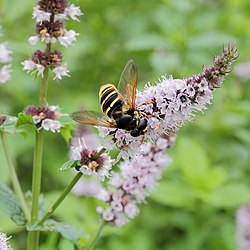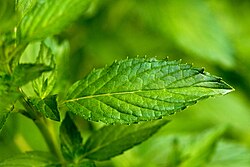Mentha
| Mentha | |
|---|---|
| Mentha spicata (Spearmint) Mentha × piperita (Peppermint) | |
| Scientific classification | |
| Kingdom: | Plantae |
| Clade: | Tracheophytes |
| Clade: | Angiosperms |
| Clade: | Eudicots |
| Clade: | Asterids |
| Order: | Lamiales |
| Family: | Lamiaceae |
| Subfamily: | Nepetoideae |
| Tribe: | Mentheae |
| Genus: | Mentha L. |
| Type species | |
| Mentha spicata | |
| Synonyms[1] | |
Mentha (also known as mint, from Greek μίνθα míntha,[2] Linear B mi-ta[3]) is a genus of plants in the family Lamiaceae (mint family).[4] The exact distinction between species is unclear; it is estimated that 13 to 24 species exist.[5][1] Hybridization occurs naturally where some species' ranges overlap. Many hybrids and cultivars are known.
The genus has a subcosmopolitan distribution across Europe, Africa – (Southern Africa), Asia, Australia – Oceania, North America and South America.[6][7] Its species can be found in many environments, but most grow best in wet environments and moist soils.
Description[edit]

Mints are aromatic, almost exclusively perennial herbs. They have wide-spreading underground and overground stolons[8] and erect, square,[9] branched stems. Mints will grow 10–120 cm (4–48 inches) tall and can spread over an indeterminate area. Due to their tendency to spread unchecked, some mints are considered invasive.[10]
The leaves are arranged in opposite pairs, from oblong to lanceolate, often downy, and with a serrated margin. Leaf colors range from dark green and gray-green to purple, blue, and sometimes pale yellow.[6]
The flowers are produced in long bracts from leaf axils.[11] They are white to purple and produced in false whorls called verticillasters. The corolla is two-lipped with four subequal lobes, the upper lobe usually the largest. The fruit is a nutlet, containing one to four seeds.
Taxonomy[edit]
Mentha is a member of the tribe Mentheae in the subfamily Nepetoideae. The tribe contains about 65 genera, and relationships within it remain obscure.[4] Authors have disagreed on the circumscription of Mentha. For example, M. cervina has been placed in Pulegium and Preslia, and M. cunninghamii has been placed in Micromeria.[12] In 2004, a molecular phylogenetic study indicated that both M. cervina and M. cunninghamii should be included in Mentha.[5] However, M. cunninghamii was excluded in a 2007 treatment of the genus.[12]
More than 3,000 names have been published in the genus Mentha, at ranks from species to forms, the majority of which are regarded as synonyms or illegitimate names. The taxonomy of the genus is made difficult because many species hybridize readily, or are themselves derived from possibly ancient hybridization events. Seeds from hybrids give rise to variable offspring, which may spread through vegetative propagation. The variability has led to what has been described as "paroxysms of species and subspecific taxa"; for example, one taxonomist published 434 new mint taxa for central Europe alone between 1911 and 1916.[12] Recent sources recognize between 18[12] and 24[1] species.[13]
Species[edit]
As of December 2020[update], Plants of the World Online recognized the following species:[1]
- Mentha alaica Boriss.
- Mentha aquatica L. – water mint, marsh mint
- Mentha arvensis L. – corn mint, wild mint, Japanese peppermint, field mint, banana mint
- Mentha atrolilacina B.J.Conn & D.J.Duval – slender mint
- Mentha australis R.Br. – Australian mint
- Mentha canadensis L. – Canada mint, American wild mint
- Mentha cervina L. – Hart's pennyroyal
- Mentha cunninghamii (Benth.) Benth. – New Zealand mint
- Mentha dahurica Fisch. ex Benth. – Dahurian thyme
- Mentha darvasica Boriss.
- Mentha diemenica Spreng. – slender mint
- Mentha gattefossei Maire
- Mentha grandiflora Benth.
- Mentha japonica (Miq.) Makino
- Mentha laxiflora Benth. – forest mint
- Mentha longifolia (L.) L. – horse mint
- Mentha micrantha (Fisch. ex Benth.) Heinr.Braun
- Mentha pamiroalaica Boriss.
- Mentha pulegium L. – pennyroyal
- Mentha requienii Benth. – Corsican mint
- Mentha royleana Wall. ex Benth.
- Mentha satureioides R.Br. – native pennyroyal
- Mentha spicata L. – spearmint, garden mint (a cultivar of spearmint)
- Mentha suaveolens Ehrh. – apple mint, pineapple mint (a variegated cultivar of apple mint)
Other species[edit]
There are a number of plants that have mint in the common English name but which do not belong to the genus Mentha:[14][15][16]
- Agastache sp. – known as horse mints
- Calamintha sp. (syn. Clinopodium) – known as calamints
- Clinopodium acinos (syn. Acinos arvensis) – known as backle mint
- Elsholtzia ciliata – known as comb mint
- Melissa officinalis – known as balm mint
- Nepeta sp. – known as cat mint or catnip
- Origanum sp. – known as rock mint
- Sideritis montana – known as sider mint
Hybrids[edit]
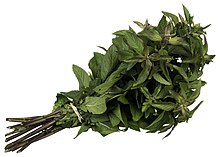
The mint genus has a large grouping of recognized hybrids. Those accepted by Plants of the World Online are listed below.[1] Parent species are taken from Tucker & Naczi (2007).[12] Synonyms, along with cultivars and varieties where available, are included within the specific nothospecies.
- Mentha × carinthiaca Host - M. arvensis × M. suaveolens
- Mentha × dalmatica Tausch - M. arvensis × M. longifolia
- Mentha × dumetorum Schult. - M. aquatica × M. longifolia
- Mentha × gayeri Trautm. - M. longifolia × M. spicata × M. suaveolens
- Mentha × gracilis Sole (syn. Mentha × gentilis) - M. arvensis × M. spicata – ginger mint, Scotch spearmint
- Mentha × kuemmerlei Trautm. - M. aquatica × M. spicata × M. suaveolens
- Mentha × locyana Borbás - M. longifolia × M. verticillata
- Mentha × piperita L. - M. aquatica × M. spicata – peppermint, chocolate mint
- Mentha × pyramidalis Ten. - M. aquatica × M. microphylla
- Mentha × rotundifolia (L.) Huds. - M. longifolia × M. suaveolens – false apple mint
- Mentha × suavis Guss. (syn. Mentha × amblardii,[17] Mentha × lamiifolia,[18] Mentha × langii,[19] Mentha × mauponii,[20] Mentha × maximilianea,[21] Mentha × rodriguezii,[22] Mentha × weissenburgensis[23]) - M. aquatica × M. suaveolens[24]
- Mentha × verticillata L. - M. aquatica × M. arvensis
- Mentha × villosa Huds. (syn. M. nemorosa) - M. spicata × M. suaveolens – large apple mint, foxtail mint, hairy mint, woolly mint, Cuban mint, mojito mint, and yerba buena in Cuba
- Mentha × villosa-nervata Opiz - M. longifolia × M. spicata – sharp-toothed mint
- Mentha × wirtgeniana F.W.Schultz (syn. Mentha × smithiana) - M. aquatica × M. arvensis × M. spicata – red raripila mint
Common names and cultivars[edit]
There are hundreds of common English names for species and cultivars of Mentha. These include:
- Apple mint - Mentha suaveolens and Mentha × rotundifolia
- Banana mint - Mentha arvensis 'Banana'
- Bowles mint - Mentha villosa and Mentha × villosa 'Alopecuroides'
- Canada mint - Mentha canadensis
- Chocolate mint - Mentha × piperita 'Chocolate'
- Corsican mint - Mentha requienii
- Cuba mint - Mentha x villosa
- Curly mint - Mentha spicata 'Curly'
- Eau de Cologne mint - Mentha × piperita 'Citrata'
- Field mint - Mentha arvensis
- Flea mint - Mentha requienii
- Ginger mint - Mentha × gracilis
- Gray mint - Mentha longifolia
- Green mint - Mentha spicata
- Grey mint - Mentha longifolia
- Japanese peppermint - Mentha arvensis var. piperascens
- Japanese mint or Japanese medicine mint - Mentha spicata 'Abura'
- Kiwi mint - Mentha cunninghamii
- Lemon mint - Mentha x piperita var. citrata and Mentha X gentilis
- Marsh mint - Mentha aquatica
- Meadow mint - Mentha x gracilis and Mentha arvensis
- Mojito mint - Mentha Spicata 'Mojito'
- Moroccan mint - Mentha spicata var. crispa 'Moroccan' and mints collected in Morocco
- Pennyroyal - Mentha pulegium
- Peppermint - Mentha × piperita and sometimes Mentha requienii
- Pineapple mint - Mentha suaveolens 'Variegata' and Mentha suaveolens 'Pineapple'
- Polemint - Mentha pulegium
- Red raripila mint - Mentha × wirtgeniana
- Round leaf mint - Mentha suaveolens
- Spearmint - Mentha spicata
- Strawberry mint - Mentha × piperita 'Strawberry'
- Swiss mint - Mentha × piperita 'Swiss'
- Tall mint - Mentha × wirtgeniana
- Tea mint - Mentha × verticillata
- Toothmint - Mentha × smithiana
- Water mint - Mentha aquatica
- Woolly mint - Mentha × rotundifolia
Cultivation[edit]

All mints thrive near pools of water, lakes, rivers, and cool moist spots in partial shade.[25] In general, mints tolerate a wide range of conditions, and can also be grown in full sun. Mint grows all year round.[26]
They are fast-growing, extending their reach along surfaces through a network of runners. Due to their speedy growth, one plant of each desired mint, along with a little care, will provide more than enough mint for home use. Some mint species are more invasive than others. Even with the less invasive mints, care should be taken when mixing any mint with any other plants, lest the mint take over. To control mints in an open environment, they should be planted in deep, bottomless containers sunk in the ground, or planted above ground in tubs and barrels.[25]
Some mints can be propagated by seed, but growth from seed can be an unreliable method for raising mint for two reasons: mint seeds are highly variable — one might not end up with what one supposed was planted[25] — and some mint varieties are sterile. It is more effective to take and plant cuttings from the runners of healthy mints.
The most common and popular mints for commercial cultivation are peppermint (Mentha × piperita), native spearmint (Mentha spicata), Scotch spearmint (Mentha x gracilis), and cornmint (Mentha arvensis);[27] also (more recently) apple mint (Mentha suaveolens).
Mints are supposed to make good companion plants, repelling pesty insects and attracting beneficial ones. They are susceptible to whitefly and aphids.
Harvesting of mint leaves can be done at any time. Fresh leaves should be used immediately or stored up to a few days in plastic bags in a refrigerator. Optionally, leaves can be frozen in ice cube trays. Dried mint leaves should be stored in an airtight container placed in a cool, dark, dry area.[28]
Uses[edit]
This section may lack focus or may be about more than one topic. In particular, it treats the genus Mentha ("mint") as if it were a single kind of plant, whereas many of the uses apply only to one species or cultivated variety of the genus. (July 2019) |
Culinary[edit]
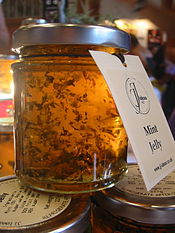
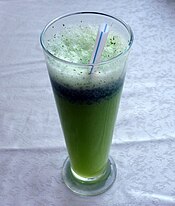
The leaf, fresh or dried, is the culinary source of mint. Fresh mint is usually preferred over dried mint when storage of the mint is not a problem. The leaves have a warm, fresh, aromatic, sweet flavor with a cool aftertaste, and are used in teas, beverages, jellies, syrups, candies, and ice creams. In Middle Eastern cuisine, mint is used in lamb dishes, while in British cuisine and American cuisine, mint sauce and mint jelly are used, respectively. Mint (pudina) is a staple in Indian cuisine, used for flavouring curries and other dishes.
Mint is a necessary ingredient in Touareg tea, a popular tea in northern African and Arab countries. Alcoholic drinks sometimes feature mint for flavor or garnish, such as the mint julep and the mojito. Crème de menthe is a mint-flavored liqueur used in drinks such as the grasshopper.
Mint essential oil and menthol are extensively used as flavorings in breath fresheners, drinks, antiseptic mouth rinses, toothpaste, chewing gum, desserts, and candies, such as mint (candy) and mint chocolate. The substances that give the mints their characteristic aromas and flavors are menthol (the main aroma of peppermint and Japanese peppermint) and pulegone (in pennyroyal and Corsican mint). The compound primarily responsible for the aroma and flavor of spearmint is L-carvone.
Mints are used as food plants by the larvae of some Lepidoptera species, including buff ermine moths. It is also eaten by beetles such as Chrysolina coerulans (blue mint beetle)[29][30] and Mint leaf beetle.[31]
Traditional medicine and cosmetics[edit]
The ancient Greeks rubbed mint on their arms, believing it would make them stronger.[32] Mint was originally used as a medicinal herb to treat stomach ache and chest pains.[33] There are several uses in traditional medicine[34] and preliminary research for possible use in treating irritable bowel syndrome.[33]
Menthol from mint essential oil (40–90%) is an ingredient of many cosmetics and some perfumes. Menthol and mint essential oil are also used in aromatherapy which may have clinical use to alleviate post-surgery nausea.[33][35]
Allergic reaction[edit]
Although it is used in many consumer products, mint may cause allergic reactions in some people, inducing symptoms such as abdominal cramps, diarrhea, headaches, heartburn, tingling or numbing around the mouth, anaphylaxis, or contact dermatitis.[33][36]
Insecticides[edit]
Mint oil is also used as an environmentally friendly insecticide for its ability to kill some common pests such as wasps, hornets, ants, and cockroaches.[37]
Room scent and aromatherapy[edit]
Known in Greek mythology as the herb of hospitality,[38] one of mint's first known uses in Europe was as a room deodorizer.[39] The herb was strewn across floors to cover the smell of the hard-packed soil. Stepping on the mint helped to spread its scent through the room. Today, it is more commonly used for aromatherapy through the use of essential oils.
Diseases[edit]
Etymology of "mint"[edit]

The word "mint" descends from the Latin word mentha or menta,[40] which is rooted in the Greek words μίνθα mintha, μίνθη minthē or μίντη mintē meaning "spearmint".[2] The plant was personified in Greek mythology as Minthe, a nymph who was beloved by Hades and was transformed into a mint plant by either Persephone or Demeter. This, in turn, ultimately derived from a proto-Indo-European root that is also the origin of the Sanskrit -mantha, mathana (premna serratifolia).
References to "mint leaves", without a qualifier like "peppermint" or "apple mint", generally refer to spearmint leaves.
In Spain and Central and South America, mint is known as menta. In Lusophone countries, especially in Portugal, mint species are popularly known as hortelã. In many Indo-Aryan languages, it is called pudīna: Hindi: पुदीना , Sindhi: ڦُودنو, Bengali: পুদিনা borrowed from Persian پودنه pudna or پونه puna meaning "pennyroyal".[41]
The taxonomic family Lamiaceae is known as the mint family. It includes many other aromatic herbs, including most of the more common cooking herbs, such as basil, rosemary, sage, oregano, and catnip.
As an English colloquial term, any small mint-flavored confectionery item can be called a mint.[42]
In common usage, other plants with fragrant leaves may be called "mint", although they are not in the mint family:
- Vietnamese mint, commonly used in Southeast Asian cuisine is Persicaria odorata in the family Polygonaceae, collectively known as smartweeds or pinkweeds.
- Mexican mint marigold is Tagetes lucida in the sunflower family (Asteraceae).
Fossil record[edit]
†Mentha pliocenica fossil seeds have been excavated in Pliocene deposits of Dvorets on the right bank of the Dnieper river between the cities of Rechitsa and Loyew, in south-eastern Belarus. The fossil seeds are similar to the seeds of Mentha aquatica and Mentha arvensis.[43]
References[edit]
- ^ a b c d e "Mentha L." Plants of the World Online. Royal Botanic Gardens, Kew. Archived from the original on 6 March 2018. Retrieved 15 July 2019.
- ^ a b μίνθα. Liddell, Henry George; Scott, Robert; A Greek–English Lexicon at the Perseus Project
- ^ Palaeolexicon Archived 2011-02-03 at the Wayback Machine, Word study tool of ancient languages
- ^ a b Harley, Raymond M.; Atkins, Sandy; Budantsev, Andrey L.; Cantino, Philip D.; Conn, Barry J.; Grayer, Renée J.; Harley, Madeline M.; de Kok, Rogier P.J.; Krestovskaja, Tatyana V. (2004). "Labiatae". In Kubitzki, Klaus; Kadereit, Joachim W. (eds.). The Families and Genera of Vascular Plants. Vol. VII. Berlin; Heidelberg, Germany: Springer-Verlag. pp. 167–275. ISBN 978-3-540-40593-1.
- ^ a b Bunsawat, Jiranan; Elliott, Natalina E.; Hertweck, Kate L.; Sproles, Elizabeth; Alice, Lawrence A. (2004). "Phylogenetics of Mentha (Lamiaceae): Evidence from Chloroplast DNA Sequences". Systematic Botany. 29 (4): 959–964. doi:10.1600/0363644042450973. JSTOR 25064024. S2CID 86816849.
- ^ a b Brickell, Christopher; Zuk, Judith D. (1997). The American Horticultural Society: A-Z Encyclopedia of Garden Plants. New York, NY: DK Publishing. p. 668. ISBN 978-0-7894-1943-9.
- ^ "Mint | Description, Genus, Species, Uses, & Facts | Britannica". 21 July 2023.
- ^ Aflatuni, Abbas; Uusitalo, J.; Ek, S.; Hohtola, A. (January–February 2005). "Variation in the Amount of Yield and in the Extract Composition Between Conventionally Produced and Micropropagated Peppermint and Spearmint". Journal of Essential Oil Research. 17 (1): 66–70. doi:10.1080/10412905.2005.9698833. S2CID 97042181. Archived from the original on 17 Jun 2007. Retrieved 10 May 2005.
- ^ Rose, Francis (1981). The Wild Flower Key. Frederick Warne & Co. p. 310. ISBN 978-0-7232-2419-8.
- ^ Brickell, Christopher; Cole, Trevor (2002). The American Horticultural Society: Encyclopedia of Plants & Flowers. New York, NY: DK Publishing. p. 605. ISBN 978-0-7894-8993-7.
- ^ Mohlenbrock, Robert H. (2014). Vascular Flora of Illinois: A Field Guide (4th ed.). Southern Illinois University Press. p. 256. ISBN 978-0-8093-3208-3.
- ^ a b c d e Tucker, Arthur O.; Naczi, Robert F. C. (2007). "Mentha: An Overview of its Classification and Relationships". In Lawrence, Brian M. (ed.). Mint: The Genus Mentha. Boca Raton, Florida: CRC Press, Taylor and Francis Group. pp. 1–39. ISBN 978-0-8493-0779-9.
- ^ "Mentha — the Plant List".
- ^ "Myntsorter".
- ^ "Mynte | lex.dk". 10 November 2022.
- ^ "Mint | Description, Genus, Species, Uses, & Facts | Encyclopædia Britannica". 21 July 2023.
- ^ "Mentha × amblardii Debeaux | Plants of the World Online | Kew Science".
- ^ "Mentha × lamiifolia Ten. | Plants of the World Online | Kew Science".
- ^ "Mentha × langii Steud. Ex Hagenb. | Plants of the World Online | Kew Science".
- ^ "Mentha × mauponii Gadeceau | Plants of the World Online | Kew Science".
- ^ "Mentha × maximilianea F.W.Schultz | Plants of the World Online | Kew Science".
- ^ "Mentha × rodriguezii Malinv. | Plants of the World Online | Kew Science".
- ^ "Mentha × weissenburgensis F.W.Schultz | Plants of the World Online | Kew Science".
- ^ "Mentha × suavis Guss. | Plants of the World Online | Kew Science".
- ^ a b c Bradley, Fern (1992). Rodale's All-new Encyclopedia of Organic Gardening. Emmaus, Pennsylvania: Rodale Press. p. 390. ISBN 978-0-87857-999-0.
- ^ "Minted". 12 August 2014. Archived from the original on 2014-08-31. Retrieved 2014-08-18.
- ^ Wees, David (4 March 2015) [first published online 8 April 2013]. "Mint, Economic Importance". The Canadian Encyclopedia. Archived from the original on 4 March 2016. Retrieved 2015-12-31.
- ^ Ortiz, Elisabeth (1992). The Encyclopedia of Herbs, Spices & Flavorings. London: Dorling Kindersley. pp. 36–7. ISBN 978-1-56458-065-8.
- ^ "Blue Mint Beetle Chrysolina coerulans". candide gardening.com. Archived from the original on 3 August 2020. Retrieved 9 May 2020.
- ^ Rosenberg, Marc (20 August 2012). "Watch out for blue mint beetle". amateurgardening.com. Archived from the original on 4 August 2020. Retrieved 7 May 2020.
- ^ "Mint leaf beetle". gardenersworld.com. Archived from the original on 22 April 2017. Retrieved 20 April 2017.
- ^ Sanderson, Helen; Renfrew, Jane M. (2005). Prance, Ghillean; Nesbitt, Mark (eds.). The Cultural History of Plants. Routledge. p. 106. ISBN 0415927463.
- ^ a b c d "Peppermint oil". National Center for Complementary and Alternative Medicine, US National Institutes of Health. 2014. Archived from the original on 2014-10-08. Retrieved 2014-10-11.
- ^ Jamila, F.; Mostafa, E. (2014). "Ethnobotanical survey of medicinal plants used by people in Oriental Morocco to manage various ailments". Journal of Ethnopharmacology. 154 (1): 76–87. doi:10.1016/j.jep.2014.03.016. PMID 24685583.
- ^ Hunt, R.; Dienemann, J.; Norton, H.J.; Hartley, W.; Hudgens, A.; Stern, T.; Divine, G. (2013). "Aromatherapy as Treatment for Postoperative Nausea". Anesthesia & Analgesia. 117 (3): 597–604. doi:10.1213/ANE.0b013e31824a0b1c. PMID 22392970. S2CID 207134623.
- ^ Bayat, R.; Borici-Mazi, R. (2014). "A case of anaphylaxis to peppermint". Allergy, Asthma & Clinical Immunology. 10 (1): 6. doi:10.1186/1710-1492-10-6. PMC 3912937. PMID 24472564.
- ^ Bounds, Gwendolyn (30 July 2009). "Death by Mint Oil: Natural Pesticides". The Wall Street Journal. Archived from the original on 2 August 2009. Retrieved 6 December 2010.
- ^ "Mint". South Texas Unit of The Herb Society of America. Archived from the original on 2013-06-29. Retrieved 2013-07-14.
- ^ Huntington, Sharon J. (18 May 2004). "A not-so-boring history of flooring". The Christian Science Monitor. Archived from the original on 2013-05-12. Retrieved 2013-07-14.
- ^ Lewis, Charlton T.; Short, Charles (1879). "menta (mentha)". A Latin Dictionary. Perseus Digital Library.
- ^ Mohammadifar, Shamameh (2022) [1 January 2000]. "Mint". Encyclopaedia Iranica (online ed.). Encyclopaedia Iranica Foundation. Retrieved 1 December 2022.
- ^ Davidson, Alan (1999). The Oxford Companion to Food. Oxford: Oxford University Press. p. 508. ISBN 978-0-19-211579-9.
- ^ Velichkevich, Felix Yu.; Zastawniak, Ewa (2003). "The Pliocene flora of Kholmech, south-eastern Belarus and its correlation with other Pliocene floras of Europe". Acta Palaeobotanica. 43 (2): 137–259. Retrieved 16 July 2019.

